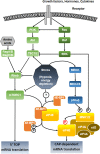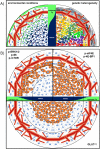Beyond molecular tumor heterogeneity: protein synthesis takes control
- PMID: 29463861
- PMCID: PMC5945578
- DOI: 10.1038/s41388-018-0152-0
Beyond molecular tumor heterogeneity: protein synthesis takes control
Abstract
One of the daunting challenges facing modern medicine lies in the understanding and treatment of tumor heterogeneity. Most tumors show intra-tumor heterogeneity at both genomic and proteomic levels, with marked impacts on the responses of therapeutic targets. Therapeutic target-related gene expression pathways are affected by hypoxia and cellular stress. However, the finding that targets such as eukaryotic initiation factor (eIF) 4E (and its phosphorylated form, p-eIF4E) are generally homogenously expressed throughout tumors, regardless of the presence of hypoxia or other cellular stress conditions, opens the exciting possibility that malignancies could be treated with therapies that combine targeting of eIF4E phosphorylation with immune checkpoint inhibitors or chemotherapy.
Conflict of interest statement
The authors declare that they have no conflict of interests.
Figures





References
-
- Global Burden of Disease Cancer Collaboration. Fitzmaurice C, Allen C, Barber RM, Barregard L, Bhutta ZA, et al. Global, regional, and national cancer incidence, mortality, years of life lost, years lived with disability, and disability-adjusted life-years for 32 Cancer Groups, 1990 to 2015: a systematic analysis for the global burden of disease study. JAMA Oncol. 2016;3:524–48. - PMC - PubMed
-
- Yong M, Jensen AO, Jacobsen JB, Norgaard M, Fryzek JP, Sorensen HT. Survival in breast cancer patients with bone metastases and skeletal-related events: a population-based cohort study in Denmark (1999-2007) Breast Cancer Res Treat. 2011;129:495–503. - PubMed
-
- Ramon y Cajal S, Capdevila C, Hernandez-Losa J, De Mattos-Arruda L, Ghosh A, Lorent J, et al. Cancer as an ecomolecular disease and a neoplastic consortium. Biochim Biophys Acta. 2017;1868:484–99. - PubMed
-
- Cahill DP, Kinzler KW, Vogelstein B, Lengauer C. Genetic instability and darwinian selection in tumours. Trends Cell Biol. 1999;9:M57–60. - PubMed
Publication types
MeSH terms
Substances
LinkOut - more resources
Full Text Sources
Other Literature Sources

